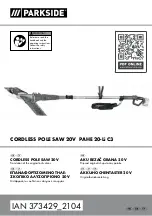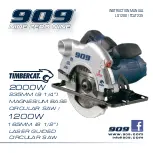
6
ELECTRICAL
REQUIREMENTS AND
SAFETY
POWER SUPPLY AND MOTOR
SPECIFICATIONS
The AC motor used in this saw is a
universal, nonreversible type.
To avoid electrical
hazards, fire hazards, or damage to the
tool, use proper circuit protection. Your
saw is wired at the factory for
120 V operation. Connect to a 120 V,
9 A circuit and use a 9 A time delay
fuse or circuit breaker. To avoid shock
or fire, if power cord is worn or cut, or
damaged in any way, have it replaced
immediately.
ELECTRICAL REQUIREMENTS -
DOUBLE INSULATED
The power tool is double insulated to
provide a double thickness of insulation
between you and tool’s electrical system.
All exposed metal parts are isolated from
the internal metal motor components with
protecting insulation.
Replacement parts –
When servicing,
use only identical replacement parts.
Polarized plugs –
This saw has a plug
that looks like the one shown below:
To reduce the risk of electrical shock,
this saw has a polarized plug (one blade
is wider than the other). This plug will fit
in a polarized outlet only one way. If the
plug does not fit fully in the outlet, reverse
the plug. If it still does not fit, contact a
qualified electrician to install the proper
outlet. Do not change the plug in any way.
WARNING
!
WARNING
!
Double insulation does
not take the place of normal safety
precautions when operating this tool.
To avoid electrocution:
• Use only identical replacement parts
when servicing a tool with double
insulation. Servicing should be
performed by a qualified technician.
• Do not use power tools in wet or damp
locations or expose them to rain or
snow.
MOTOR SAFETY PROTECTION
IMPORTANT:
To avoid motor damage, the motor should
be blown out or vacuumed frequently to
keep sawdust from interfering with the
motor ventilation.
•
Connect
this saw to a 120 V, 9 A circuit
with a 9 A time-delay fuse or circuit
breaker. Using the wrong size fuse can
damage the motor.
• If the motor will not start, release the
trigger switch immediately.
UNPLUG
THE SAW
. Check the saw blade to
make sure it turns freely. If the blade
is free, try to start the saw again. If the
motor still does not start, refer to the
TROUBLESHOOTING GUIDE
.
• If the tool suddenly stalls while cutting
wood, release the trigger switch,
unplug the tool and free the blade from
the wood. The saw may now be started
and the cut finished.
•
FUSES
may “blow” or circuit breakers
may trip frequently if:
•
MOTOR
is overloaded – overloading
can occur if you feed too rapidly or
make too many start/stops in a short
time.
•
LINE VOLTAGE
is more than 10%
above or below the nameplate
voltage rating. For heavy loads,
the voltage at motor terminals must
equal the voltage specified on the
nameplate.
•
IMPROPER
or dull saw blades are
used.
Polarized plugs







































